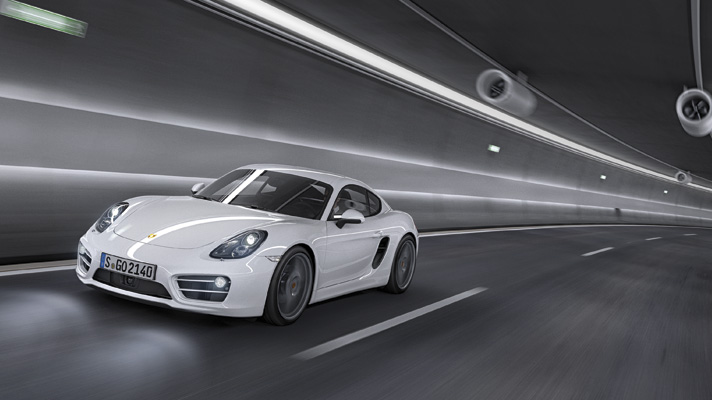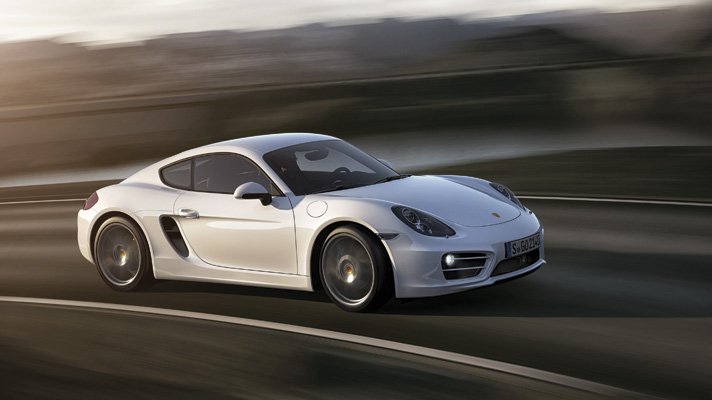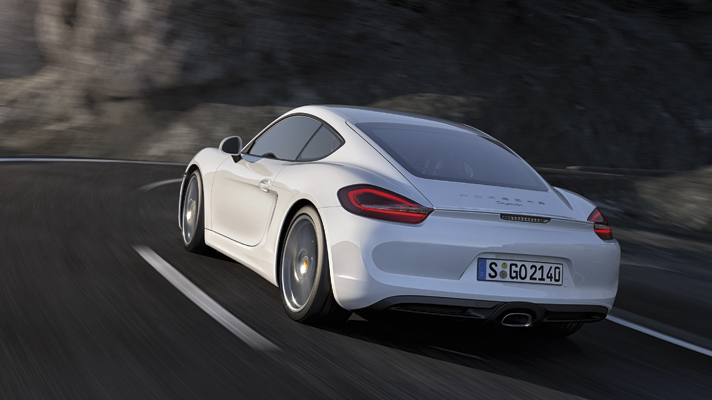
The 2013 Porsche Cayman lands in LA
Porsche better be working on something pretty special for the next 911, because this faster, lighter more focused third-gen Cayman looks like it'll be nipping at the flagship's heels. Let's do some numbers...
It's up to 30 kg lighter, 40 per cent stiffer, 15 per cent more efficient and 10bhp more powerful than its predecessor, which was in itself, an excellent car.
And the engines. You can chose from two directly injected flat sixes - a 2.7-litre and 3.4-litre, both of which have been designed to rev more freely than before (peak power arrives at 7,400rpm - the old models run out of breath at 7,200rpm). More revs, in this case, means more power.
Even though the new 2.7 has 0.2-litres less displacement than the engine it replaces (the 2.9), at 275bhp it actually makes 10bhp more than its predecessor. The bigger 3.4's also up by 5bhp to 325bhp in the S model. The power curves for both are a notch above the outgoing engines too, so they make more power at the same RPM.
Now Porsche has stapled on a bunch of clever electrical stuff, they're up to 15 per cent more efficient too (the 2.7 does 34.4mpg and the 3.4 32.1mpg). The battery gets charged more intensively during braking and coasting phases, and the alternator charge current can be reduced when the battery is fully charged. There's also intelligently controlled engine and transmission cooling systems, so they both reach their operating temperatures more rapidly, helping combustion efficiency under part-load and minimising gearbox friction.
If you go for the double-clutch seven-speed PDK, you also get a coasting function, just as you'd find on the new 911. The ‘box decouples so the engine runs in neutral when you're putting any power through it, and Porsche reckons it can save up to one litre of fuel per 100 km, helped in part seven per cent reduction in rolling resistance. But if you've any sense, you'll go for the standard six-speed manual transmission.
Now, the body. It's entirely new, 47kg lighter and made up of steel and aluminium, only using the former when strictly necessary (around 44 per cent of the new Cayman shell is aluminium). But despite the weight saving, torsional rigidity's increased by 40 per cent, which seems staggering considering how well the outgoing car handled. Porsche promise that it "drives more precisely than ever before" but we hope it's not lost any of the old ‘uns lovely ride quality.
Underneath, there's a new chassis system and 60 mm more wheelbase, and Porsche has played with the PASM active damping and added a few more sensors to inform the computers. Four new vertical sensors at the front and rear wheels - and Normal and Sport buttons on the dash - help it work out how stiffly to set the suspension.
There are many more exciting acronyms available as optional extras to help the going get sporty - the Porsche Torque Vectoring (PTV) system basically improves the vehicle's steering response and steering precision by targeted brake interventions at the rear wheel located on the inside of a bend. The rear differential lock then helps with things when you're accelerating out of the bend.
New electro-mechanical power steering replaces the previous car's hydraulic setup. And even if electric power steering makes driving most sports cars feel like eating a sweet with the wrapper on, this one has the relatively pleasing side-effect of reducing fuel consumption by at least 0.1 l/100 km.
Top Gear
Newsletter
Thank you for subscribing to our newsletter. Look out for your regular round-up of news, reviews and offers in your inbox.
Get all the latest news, reviews and exclusives, direct to your inbox.
Need more sharpness? Option the Sport Chrono package. There's a Sport Plus button also activates the PDK ‘race course' shifting map, dynamic transmission mounts, which alter their stiffness and damping rates depending on driving conditions. With the mountings set to stiff, the drivetrain's moment of inertia is reduced when you go into a bend, which helps with steering precision.
Suppose you want to know about performance now, don't you? The 2.7 does 0 - 62 mph in 5.7 sec (5.6 with PDK and 5.4 sec with Sport Chrono package) and onto a top speed of 165 mph. The Cayman S will do 0 - 62 mph In 5.0 sec (4.9 with PDK 4.9 and 4.7 sec with Sport Chrono) and a top speed of 176 mph.
Drawing it up are a set of new, stiffer front brake callipers with a new brake pad design and a larger brake contact surface. Probably a good thing - the old car's stoppers did tend to err on the mushy side.
There's also been a few aero tweaks. A new front spoiler lip helps keep the nose pinned, and the resculpted wing, which will deploy automatically or manually and has a 40 per cent larger effective area, keep its backside in check.
So, now the awkward bit - pricing. The 2.7-litre starts at £39,694 and the 3.4-litre S at £48,783. Typically, Porsche aren't being too lavish with standard equipment - there's air-con, CD audio with seven-inch touch-screen control screen, automatic headlight activation, auto stop-start function, electronic parking brake, ‘Sport' button, 18-inch alloy wheels, top tinted windscreen and, erm, floor mats.
Realistically, then, a tenable car will be nudging £50,000. So, nearly as quick as a base-spec 911, and 20k cheaper. Which seems a lot for some tiny rear seats, don't you think, TopGear.commers?
Trending this week
- Car Review
BMW 1 Series
- Top Gear's Top 9
Nine dreadful bits of 'homeware' made by carmakers










